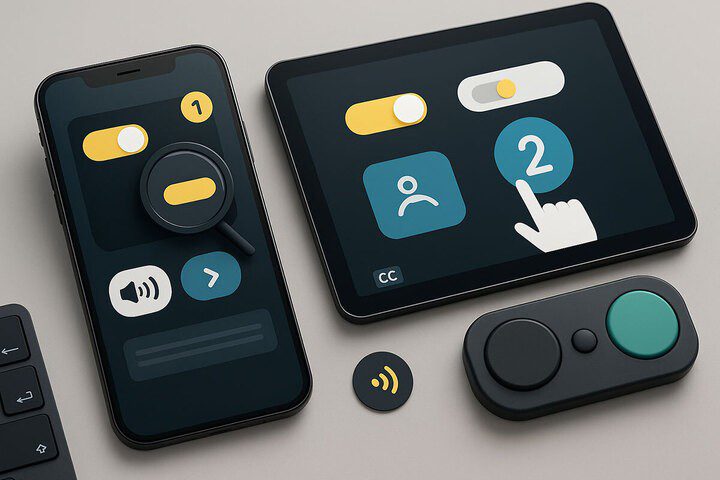The Role of Accessibility in App Tutorials and Walkthroughs
Accessibility in app development is a core tenet of inclusive design and no longer a niche issue. Many users’ initial experience of an app is through a tutorial or walkthrough. These tutorials are essential to user uptake, but if they are not accessible, they act as major barriers.



An inaccessible tutorial/walkthrough can cause frustration and bewilderment, and users may give up on the app before they have even been able to tap into its worth. Making sure that all users, no matter what their ability, are able to comprehend and find their way through these first-time guides is crucial for establishing a friendly and successful user experience. This dedication to accessibility not only helps users with disabilities but also the entire user population, improving clarity and usability for everyone. Read on to understand the important role of accessibility in app tutorials and walkthroughs.
Why Accessible Tutorials Are a Must-Have
Creating app tutorials for accessibility isn’t simply a compliance issue; it’s a business choice that increases the reach of a product and enhances overall quality.
A tutorial that will be straightforward for a screen-reader user will also be more intuitive for a sighted user. A video with captions and audio descriptions is useful for a person with a hearing or visual impairment, but it is also useful for a user in a crowded public area or for a viewer who wants to watch without sound.
Addressing possible barriers up front makes developers stronger and more resilient. The guidelines of inclusive design, such as giving a similar experience, choice, and control to the user, are directly applicable to tutorials so that any individual can learn to use an app properly.
Best Practices for Creating Accessible Video and Interactive Tutorials
Video tutorials are a popular method for guiding users through an app’s features, but they must be made accessible to be effective.
- Captions and Transcripts: All audio content should include correct, time-synchronized captions. For visually impaired users who cannot view the video, a descriptive transcript is crucial. An in-depth transcript should include both the dialogue and descriptions of important visual details, including text that appears on screen or action. The presence of a robust tool, such as a video translator, can easily make this task efficient. This software utilizes AI for translating video content and producing precise transcripts and voiceovers in various languages, thus making tutorials accessible across the globe.
- Avoid Flashing Content: Tutorials in videos should not have any flashing content that occurs more than three times a second to avoid triggering seizures in users suffering from photosensitive epilepsy.
- Audio Descriptions: In video content where there is information provided visually that is not covered by the dialogue, include an independent audio track describing what is on screen. This is essential for users with visual impairment or blindness.
- Control and Usability: Give complete control to users over the video. This means play, pause, stop, and volume controls that are simple and accessible for assistive technologies. Users must be able to turn off any automatically playing content.
Designing Accessible App Walkthroughs and UI
Accessible app tutorials aren’t just restricted to video; they are also in-app walkthroughs and user interface components.
- High Contrast and Legibility: Text and graphics within your tutorials should have an adequate color contrast ratio so that they can be read by low vision or color blind users. The Web Content Accessibility Guidelines (WCAG) suggest a minimum of 4.5:1 for normal text.
- Clear and Simple Language: Write in simple, clear language. Make no use of jargon, technical words, or unnecessarily complicated sentences. This especially goes for users with cognitive disabilities or non-native speakers of the app’s language.
- Keyboard and Screen Reader Navigation: Any interactive content in a tutorial, including buttons, hotspots, or checklists, should be navigated by means of a keyboard. Ensure that screen readers can properly read and identify each item and describe it with clear, concise labels. For instance, where a screen reader says “button,” use “Next step button” or “Complete task button.”
- Scalable Text and Responsive Design: Make sure that users are able to scale the size of text within the tutorial without the layout breaking. The whole tutorial needs to change shape according to different screen sizes and orientations, and should be accessible on a range of devices and by those who employ zoom functions.
Incorporating Inclusive Design Right from the Beginning
In order to ensure real accessibility, it needs to be incorporated in the app development process right from the start. Thismeans:
- User Research: Engage individuals with disabilities in the testing and design process. Their firsthand comments are precious for detecting and solving issues of accessibility that automated testing can’t detect.
- Training and Awareness: Train the entire design and development team on accessibility principles and best practices. A culture of accessibility ensures inclusive design is prioritized across the entire app lifecycle, from conceptualization to deployment.
- Automated and Manual Testing: Employ a mix of automated accessibility checkers and manual testing using assistive technologies. Tools can detect most common mistakes, yet a human tester reading using a screen reader or other assistive technology can offer a better understanding of the user experience.
Conclusion
The dedication to producing app tutorials and walkthroughs that are accessible is an extension of a larger commitment to universal design. Through applying best practices like delivering accurate captions, utilizing high-contrast imagery, and keyboard access, developers can create bridges instead of barriers. The outcome is a more user-friendly, effective, and ethical product that can benefit a broader audience.
Related Apps
Latest News
- The Role of Accessibility in App Tutorials and Walkthroughs
- The Role of Mobile Apps in Improving Student Performance
- How to Use Proxy for Third-Party Marketplaces
- The Role of UX/UI in Increasing App Retention: Lessons from Alternative App Marketplaces
- Hire Python Developers: Powering Your Projects with Versatile and Future-Proof Skills
- What is a desk booking system?







